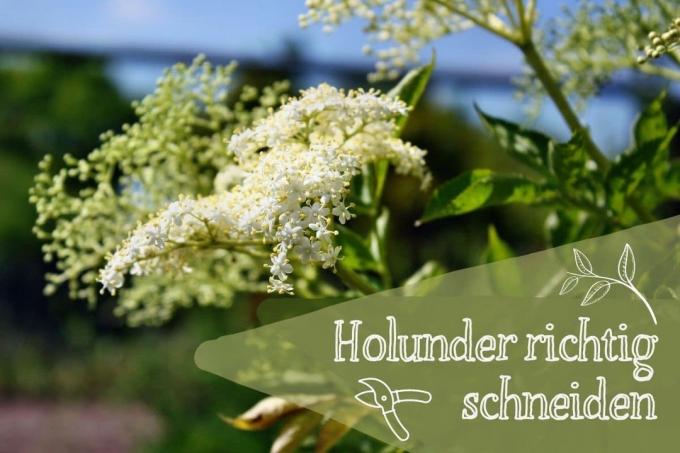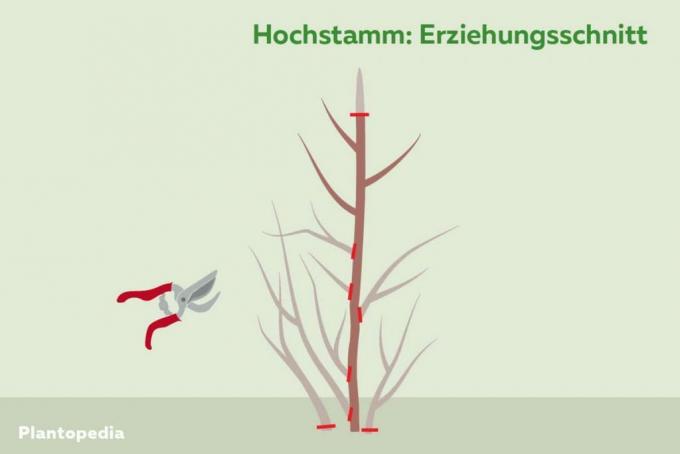
table of contents
- The best time
- Tools and aids
- Thinning out elderberry
- Care cut
- Taper cut
- Standard trunk: parenting style
- frequently asked Questions
Elder is one of the native plants that are most compatible with pruning. If you follow our tips when pruning elderberries, you will not only be able to curb the vigorous growth, but also increase harvest yields or effectively prevent the shrub from aging.
In a nutshell
- the typical cutting time is between autumn and spring
- lighting takes place over the entire season
- Elderberry is easy to cut and easy to grow
- a good cut will strengthen the new shoot in the coming year
The best time
In order to ideally prune an elder, you need to choose the right date so that the plant can recover after pruning. Intensive editing is an exception. If, for example, you want to put the elderberry completely on the stick or cut it back heavily (e.g. after an illness), according to § 39 of the German Federal Nature Conservation Act (BNatSchG), this may only occur between the 1st of October and 1. March happened. The reason: from spring to autumn, wood and trees provide shelter for numerous animals that must not be removed. Only maintenance and contour cuts are permitted outside of this period, as long as the loss of material is not too high. If you fail to adhere to the deadline, you can expect fines of up to 50,000 euros. The other pruning measures are recommended at the following time:

- Mid-September to early March
- exact date depending on the cutting measure
- dry day
- Frost free
- covered
Note: Make sure not to cut the elderberry too late in spring, as otherwise there is a risk of blossom failure.
Tools and aids
Before you can start cutting, you need the right tools. With the right tool, you reduce the cost of cutting and improve the result. Thoroughly disinfect the tools before cutting, especially if previously diseased plants have been cut with them. This prevents pathogens from getting into the open wound sites. The same goes for blunt tools. Crushing or tearing the tools increases the risk of diseases caused by fungi, bacteria and viruses. The following list gives you an overview of the necessary tools for the Sambucus cut:
- Rose or secateurs
- Loppers
- ladder
- optional: pruning saw (for thick branches)
- optional: telescopic pole

Thinning out elderberry
To the classic cutting measures on one Sambucus includes regular thinning. Since elderberry grows extensively regardless of the species and sprouts again and again even after brutal pruning, you have to care for it thoroughly. Fortunately, only minor measures are required to give the wood sufficient strength. Elderberry plants are not exposed during the cooler seasons. They take care of the wood throughout the season if it is necessary. The aim of thinning out is to remove exhausting branches. These just have to be cut off. This includes the following shoots and branches:
- broken
- dried up
- ailing
- got sick
- growing inward
- growing diagonally outwards
Tip: You can completely remove biennial branches if they have not formed new branches. In most cases, these only get longer, but no longer have a positive effect on the structure of the elder.
Care cut
In addition to regular thinning, it is particularly important to care for the elder once a year. The maintenance cut serves to maintain the natural growth form and health of the Sambucus so that it can grow vigorously in the coming season. The approach is not difficult, but the effort can be quite high depending on the size of the elderberry. With the following instructions, you will be able to cut back by mid-October at the latest:

- Cut the harvested shoots first
- can be recognized by the fact that they hang down
- Shorten by 2/3 or remove completely
- Place the cutting tool at an angle of 3 to 5 mm above one eye
- Then thin the elderberry well
- only fresh and healthy wood should remain
- now the young shoots follow
- recognizable by the bark: smooth, light gray
- Select 10 to 13 healthy young shoots
- should be as close to the base or trunk as possible
- only shorten if it is too long
- Completely remove remaining young shoots
- if necessary, shorten all remaining shoots by 1/3
- Shorten shoots that are too long according to the optics
- Due to its robustness, wound closure agents are not necessary
- Then dispose of the clippings
- Do not dispose of diseased or pest-infested clippings on the compost
Note: If you have not been able to cut the elder, you can suspend the cut for a season if there is no case of illness.
Taper cut
If the sambucus has not been cut for a longer period of time, it will begin to age. This particularly affects the branches close to the ground, as they no longer receive enough light and are becoming increasingly bald. A rejuvenating cut should also be used when the elder has grown very high and harvesting is no longer possible without a ladder or is no longer possible at all. To fix this problem, you need to apply an intense taper cut. Fortunately, the wood is very robust, which makes even such pruning measures possible without any problems. The following instructions will help you with the cut:

- is cut at the end of winter or the beginning of spring
- Select day without risk of night frost
- Cut back the shrub radically
- cut as much as necessary
- also remove thick branches
- Cut back to the bottom
- leave 10 to 15 shoots at the end
- choose the healthiest ones for this
- free the selected shoots from unnecessary branches and twigs
Note: After the rejuvenation pruning, you will have to do without flowering and berries in the same year. The shrub will not fully recover until the next season.
Standard trunk: parenting style
In addition to the forms already mentioned, the parenting pattern must be mentioned. Many gardeners prefer their elderberry plants as a high stem, as they take up significantly less space and make harvesting the flowers or berries easier. While pruning is more commonly used than topiary, proper parenting requires a different approach. The ideal approach as follows:

- Plant cuttings or young plants in autumn
- remove all shoots except for the middle one
- Central shoot should be strong
- leave the 3 healthiest shoots on the central shoot
- should be in the upper part of the central drive
- Remove the remaining shoots on the central shoot
- In the coming spring, cut off the lower shoots again
- Check shaping shoots for health in June
- then shorten
- at the latest by Midsummer Day (24. June)
- do so in the years to come
- the standard form becomes clearer every year
- Don't forget to thin out over the years
frequently asked Questions
The cut of an elder hedge is only possible from the 2nd Standing year recommended. After that, you should thin out the hedge every year so that it does not get too big. The pruning is done in spring, as it does not require a complete maintenance cut. Remove the oldest shoots that are growing on the ground and any overhanging wood that is no longer strong enough. Long young shoots from last season are significantly shortened or removed.
The biggest advantage of Sambucus plants is the possibility of doing without the pruning completely. But this is only possible if you prefer a naturally growing elderberry bush. The shrub will then simply grow unhindered, which will affect its size and shape accordingly. For this reason, enough space is essential if you do not want to use any pruning measures.
If you want to harvest the aromatic elderflower, you have to cut them off. Remember that harvested flowers can no longer produce berries. It is harvested during the elderflower on dry, sunny days before noon. Cut off the entire flower and stow it in a basket, as bags have a negative effect on its freshness. Shake the cones before use to remove bugs and debris.



